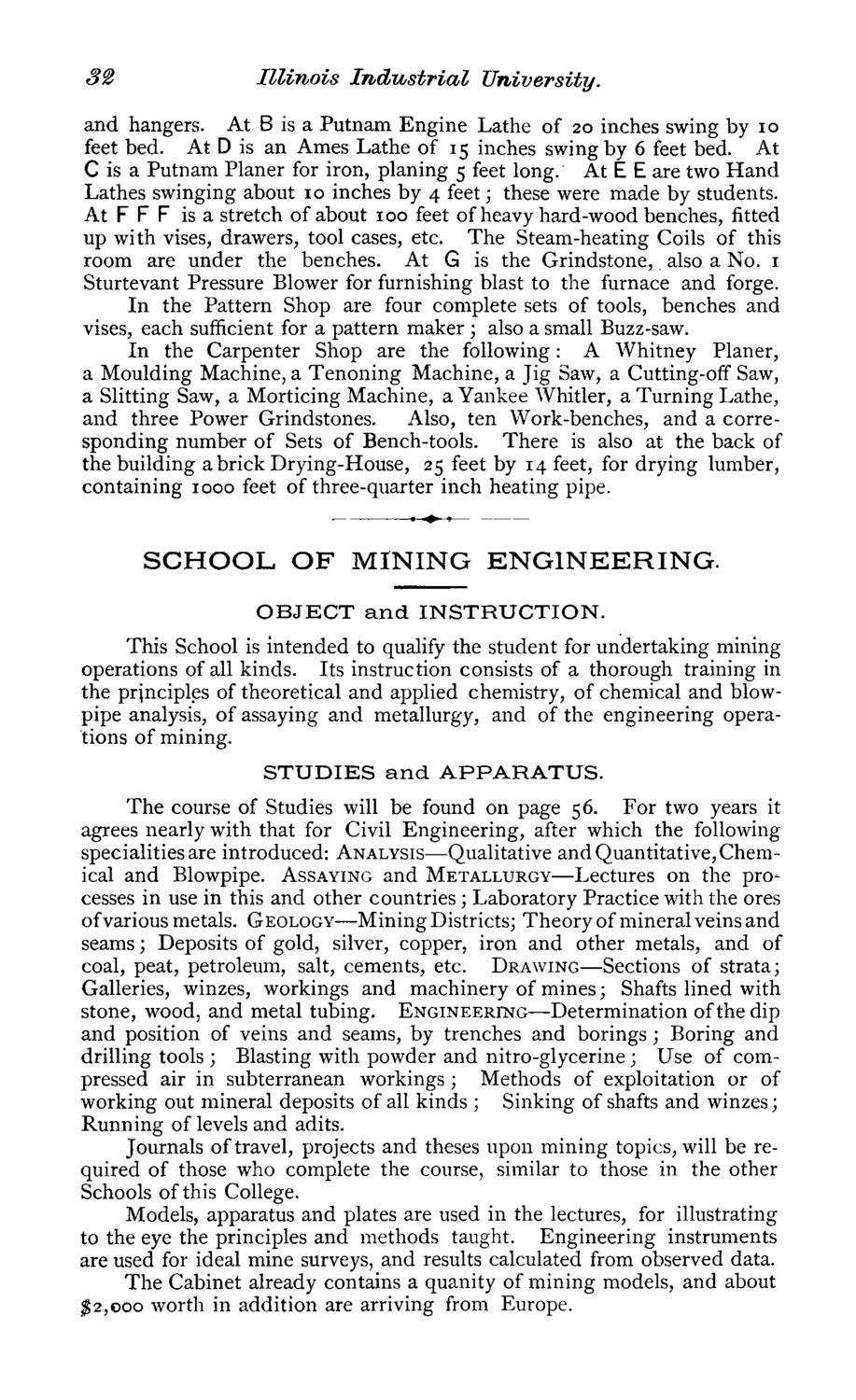| |
| |
Caption: Course Catalog - 1872-1873
This is a reduced-resolution page image for fast online browsing.

EXTRACTED TEXT FROM PAGE:
32 Illinois Industrial University. and hangers. At B is a Putnam Engine Lathe of 20 inches swing by 10 feet bed. At D is an Ames Lathe of 15 inches swing by 6 feet bed. At C is a Putnam Planer for iron, planing 5 feet long. At E E are two Hand Lathes swinging about 10 inches by 4 feet; these were made by students. At F F F is a stretch of about 100 feet of heavy hard-wood benches, fitted up with vises, drawers, tool cases, etc. The Steam-heating Coils of this room are under the benches. At G is the Grindstone, also a No. 1 Sturtevant Pressure Blower for furnishing blast to the furnace and forge. In the Pattern Shop are four complete sets of tools, benches and vises, each sufficient for a pattern maker ; also a small Buzz-saw. In the Carpenter Shop are the following: A Whitney Planer, a Moulding Machine, a Tenoning Machine, a Jig Saw, a Cutting-off Saw, a Slitting Saw, a Morticing Machine, a Yankee Whitler, a Turning Lathe, and three Power Grindstones. Also, ten Work-benches, and a corresponding number of Sets of Bench-tools. There is also at the back of the building a brick Drying-House, 25 feet by 14 feet, for drying lumber, containing 1000 feet of three-quarter inch heating pipe. SCHOOL OF MINING ENGINEERING. OBJECT a n d INSTRUCTION. This School is intended to qualify the student for undertaking mining operations of all kinds. Its instruction consists of a thorough training in the principles of theoretical and applied chemistry, of chemical and blowpipe analysis, of assaying and metallurgy, and of the engineering operations of mining. STUDIES a n d APPARATUS. The course of Studies will be found on page 56. For two years it agrees nearly with that for Civil Engineering, after which the following specialities are introduced: ANALYSIS—Qualitative and Quantitative, Chemical and Blowpipe. ASSAYING and METALLURGY—Lectures on the processes in use in this and other countries; Laboratory Practice with the ores of various metals. GEOLOGY—Mining Districts; Theory of mineral veins and seams; Deposits of gold, silver, copper, iron and other metals, and of coal, peat, petroleum, salt, cements, etc. DRAWING—Sections of strata; Galleries, winzes, workings and machinery of mines; Shafts lined with stone, wood, and metal tubing. ENGINEERING—Determination of the dip and position of veins and seams, by trenches and borings; Boring and drilling tools ; Blasting with powder and nitro-glycerine; Use of compressed air in subterranean workings; Methods of exploitation or of working out mineral deposits of all kinds ; Sinking of shafts and winzes; Running of levels and adits. Journals of travel, projects and theses upon mining topics, will be required of those who complete the course, similar to those in the other Schools of this College. Models, apparatus and plates are used in the lectures, for illustrating to the eye the principles and methods taught. Engineering instruments are used for ideal mine surveys, and results calculated from observed data. The Cabinet already contains a quanity of mining models, and about $2,000 worth in addition are arriving from Europe.
| |